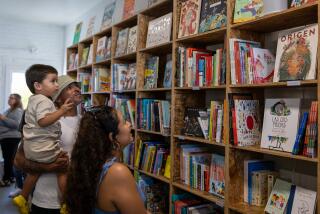Modern Times Take a Toll on History
- Share via
LIMA, Peru — Delfina Gonzales carefully swings open the heavy steel door of a refrigerator-sized safe containing jewels from Peru’s past: dozens of irreplaceable antique books, many with their covers eaten away by moths or torn by years of use.
These volumes are rarely brought out for display at Peru’s once-grand National Library, where the ravages of humidity, auto exhaust and decay are taking a heavy toll in one of the world’s most important repositories of papers from the Spanish colonial era.
Librarians are hampered with an inadequate arsenal -- aging vacuum cleaners, a couple of household air purifiers, soft-bristle brushes. Gonzales, one of the library’s chief researchers, longs for high-tech equipment and climate-control systems to halt the deterioration.
“This page is so fragile and damaged, as much by humidity as by air pollution,” said Gonzales, carefully leafing through a 450-year-old copy of Lope de Gomara’s account of the Spanish conquest. The yellowed, frayed margins contain notes by Garcilaso de la Vega, son of a conquistador and an Inca princess, who in his time penned the most influential accounts of Inca history and culture.
Other gems include some of the first books printed in Peru in the 1580s and a book about palm reading printed in Venice in 1489 that once belonged to Argentine Gen. Jose de San Martin.
San Martin founded the library in 1821, the same year his forces drove Spain out and established an independent Peru.
Donating his collection, San Martin said he hoped the library would serve as “one of the most effective mediums to put intellectual values in circulation.”
Today, despite its limited budget, the National Library remains an invaluable tool to scholars of the continent’s Spanish colonial past. After Spanish conquistador Francisco Pizarro founded Lima in 1535, it became the wealthy capital of Spain’s South American empire and home to the most important books of the day.
The Peruvian collection has had its share of troubles. Sixty years after San Martin founded the library, it was left to laureate Ricardo Palma to restore the collection’s greatness after occupying Chilean troops plundered it during the 1879-83 War of the Pacific. In 1943, historian Jorge Basadre handled the task of rebuilding and modernizing the library after a catastrophic fire.
Today, Lima’s peculiar climate and the museum’s location in the decaying downtown are the main culprits that transform classics into mildewed pulp.
During the winter, fog rolls in from the Pacific, blanketing the city with a bone-chilling dampness that can keep humidity at 100% for long stretches. Meanwhile, air quality studies have shown that Abancay Avenue, the eight-lane thoroughfare outside the library, is one of the most polluted streets in Latin America.
While the library’s most prized items are protected in individual airtight containers, an internal audit last year estimated that 62% of its 1 million books, valued at $364 million, are in a state of deterioration. The library estimates that in the next 10 to 30 years, $215 million worth of the collection could be lost if immediate steps are not taken to upgrade the preservation system.
Seeking to head off a cultural disaster, the government approved a plan to move a large portion of the collection, including the most fragile books, to a new, modern building across town. But the library’s director, Sinesio Lopez, says funds have been slow in coming.
The government came up with $2.8 million to build the new library, scheduled for opening next year. But $10 million more is needed to fully furnish it with tables, chairs and bookshelves, and equip it with the hermetic climate-control system that the old library lacks, Lopez said.
The library is looking to international foundations and foreign companies for assistance to bridge the funding gap.
More to Read
Sign up for Essential California
The most important California stories and recommendations in your inbox every morning.
You may occasionally receive promotional content from the Los Angeles Times.













